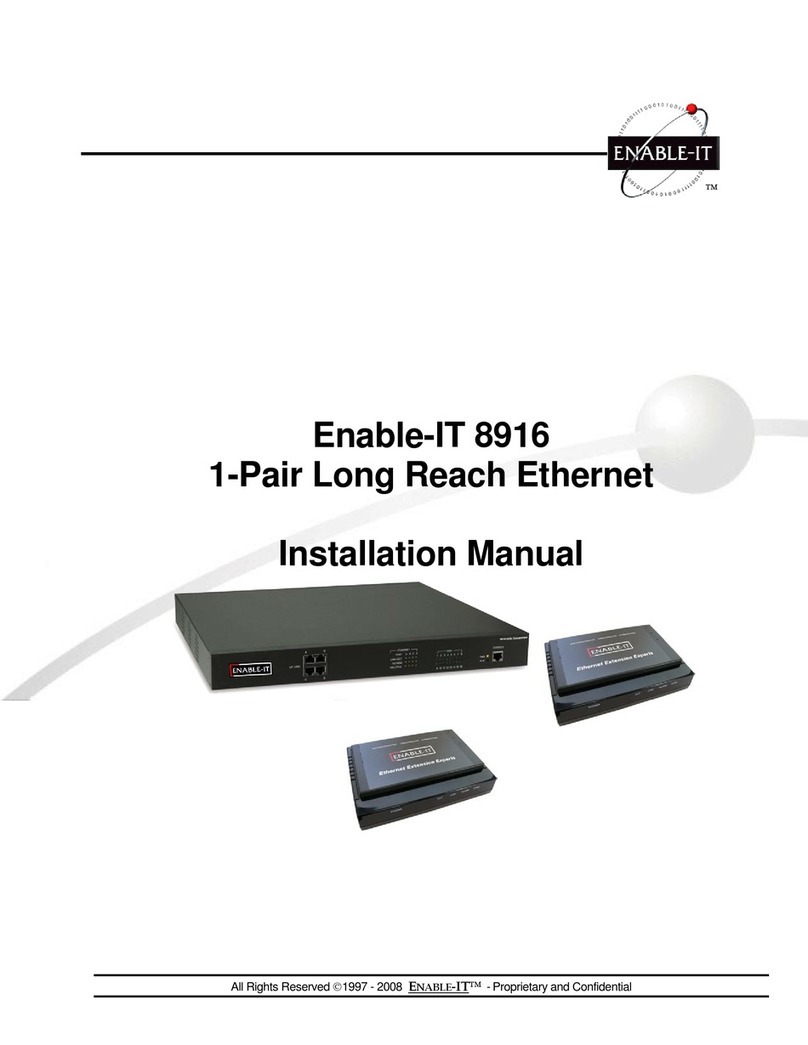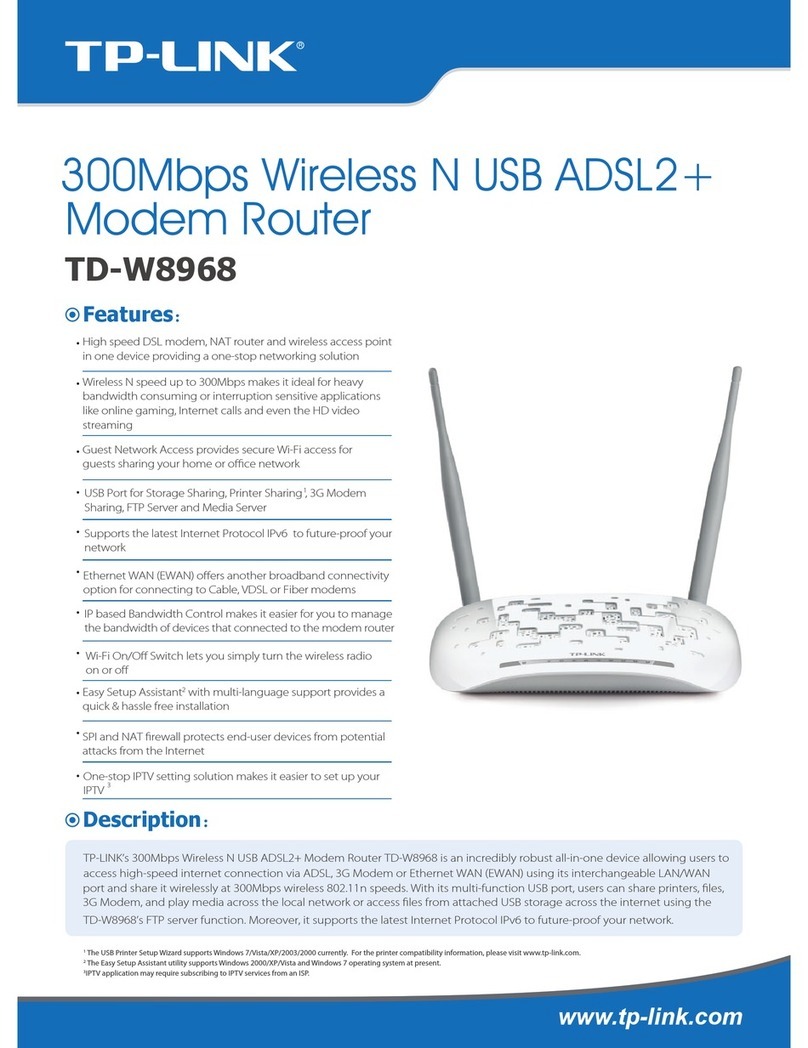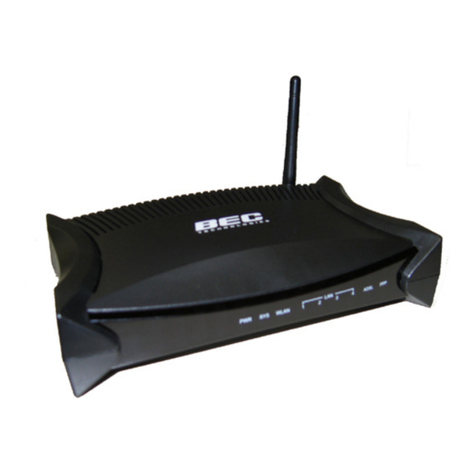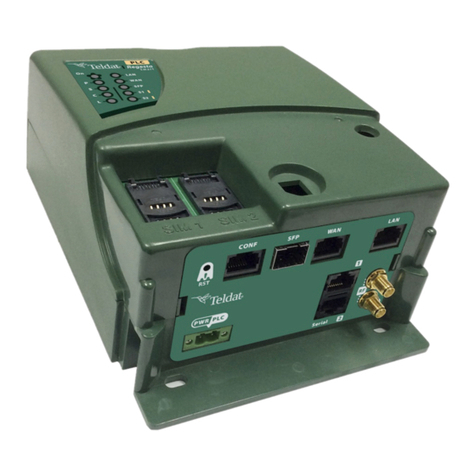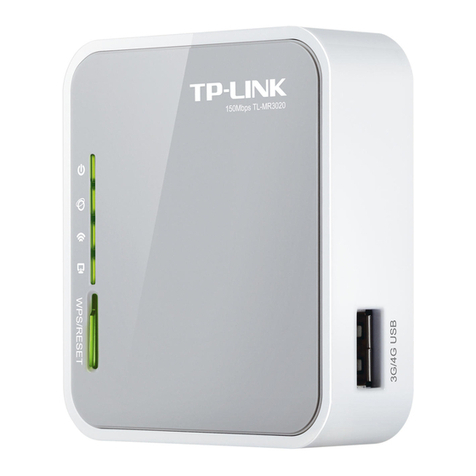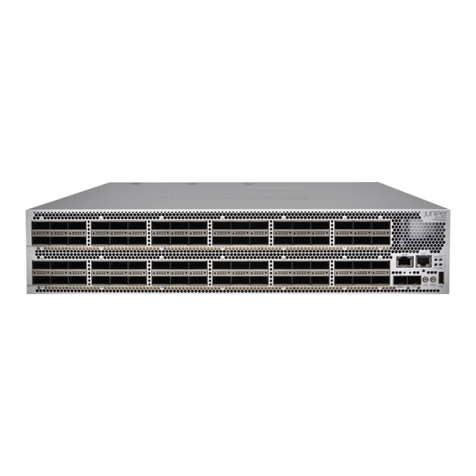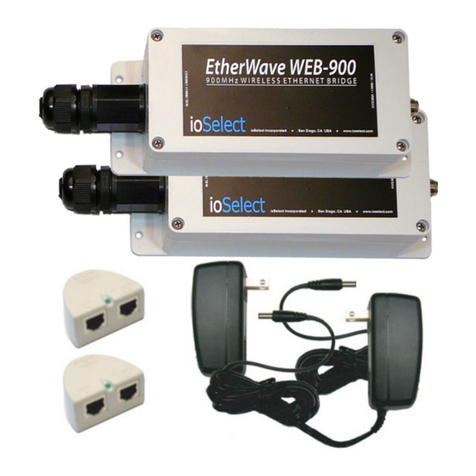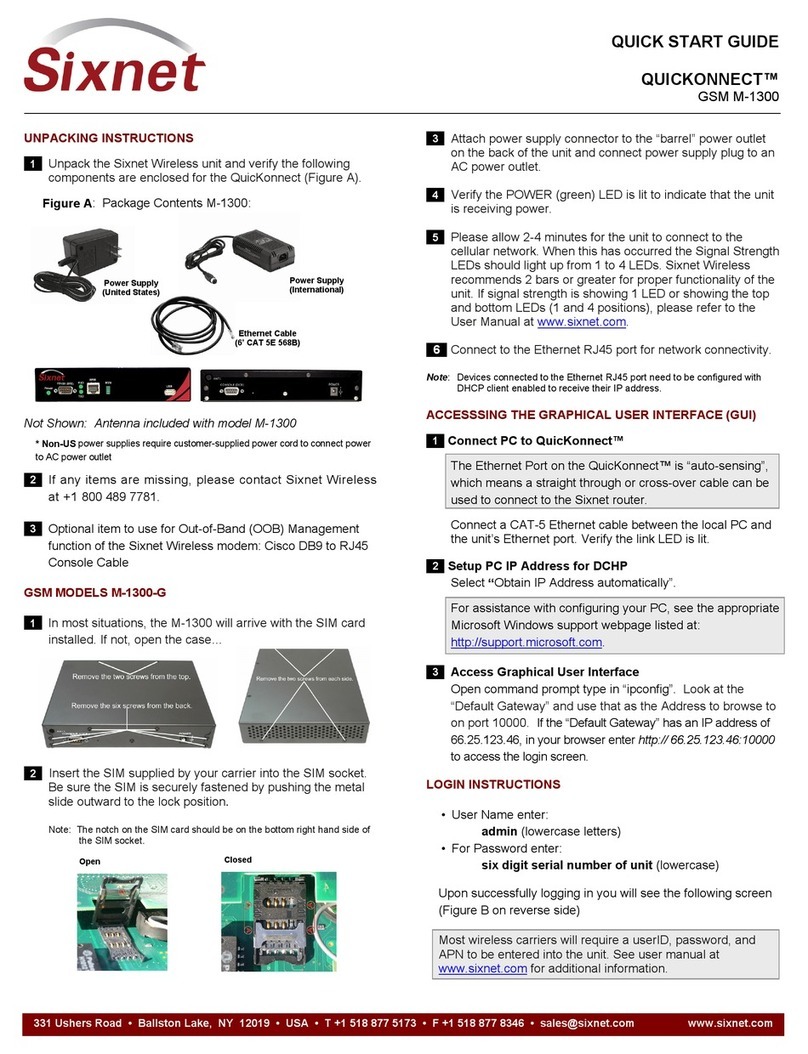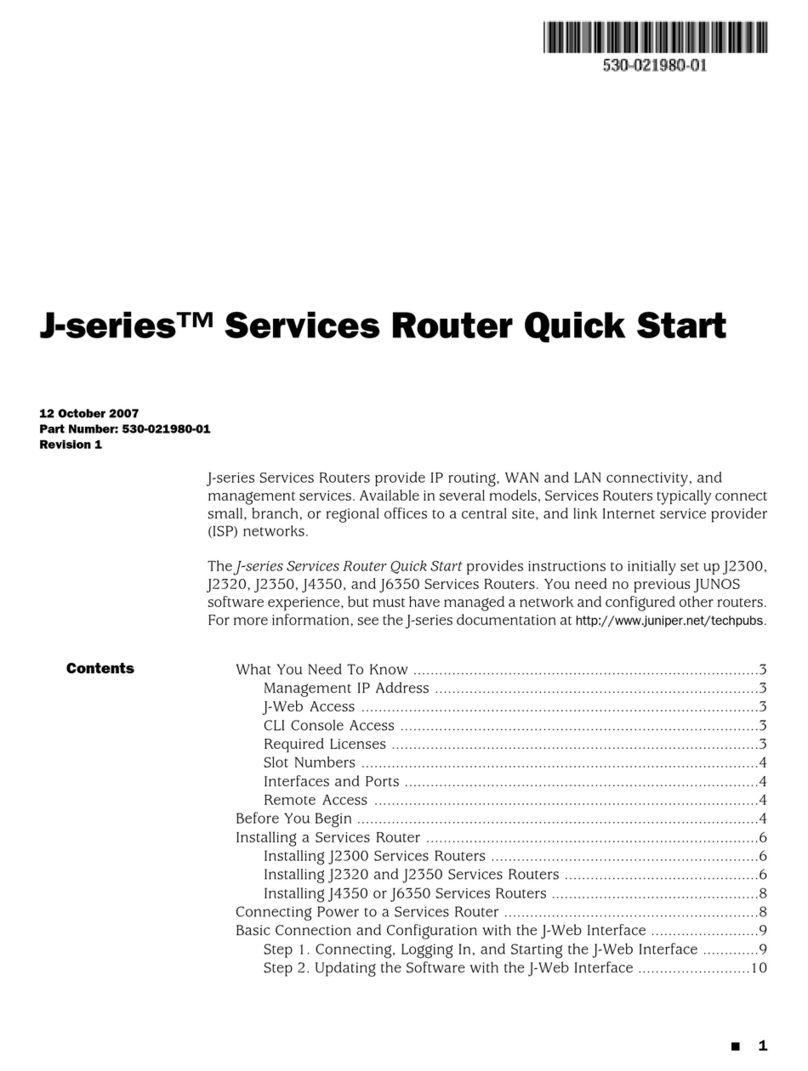movistar Xavi 7968 User manual

1
ADSL Router
Freedom
in a box
Installation guide

2

3
For further information please refer to the User’s manual on the Advanced Settings CD, section 2, or the
glossary section in this guide.
Package contents
(7) Advanced settings CD (8) Warranty card
This guide details about the start up process for your Internet connection. You will
be able to enjoy your connection in an easy, simple and quick way. Please follow the
guide instructions step by step.
The Advanced Settings CD includes a video le (AyudaGraca.exe) with a graphic help of
the installation and conguration of your Internet connection.
(2) Power adapter
(5) Telephone line cable (6) Ethernet cable
(1) Wireless router (3) Three ADSL microlters
(4) Multiple adapter
2
0
1
0
T
e
l
e
f
ó
n
i
c
a
d
e
E
s
p
a
ñ
a
S
.
A
.
U
.
R
e
s
e
r
v
a
d
o
s
t
o
d
o
s
l
o
s
d
e
r
e
c
h
o
s
.
Q
u
e
d
a
p
r
o
h
i
b
i
d
a
l
a
r
e
p
r
o
d
u
c
c
i
ó
n
t
o
t
a
l
o
p
a
r
c
i
a
l
,
a
s
í
c
o
m
o
l
a
v
e
n
t
a
d
e
e
s
t
e
C
D
-
R
O
M
.
C
u
a
l
q
u
i
e
r
f
o
r
m
a
d
e
c
o
m
e
r
c
i
a
l
i
z
a
c
i
ó
n
,
e
x
h
i
b
i
c
i
ó
n
o
r
e
p
r
o
d
u
c
c
i
ó
n
d
e
e
s
t
e
C
D
-
R
O
M
d
a
r
á
l
u
g
a
r
a
l
a
s
r
e
s
p
o
n
s
a
b
i
l
i
d
a
d
e
s
p
e
r
t
i
n
e
n
t
e
s
.
V 1.0
00412849
Router
ADSL

4
For further information please refer to sections 3.2 and 3.3 of the user’s manual on the Advanced Settings CD
Start using your ADSL…
1. Microlters installation 2. Telephone line connection
Connect a microlter between each tele-
phony device (telephones, faxes,…) and
the telephone socket.
Connect the multiple adapter (4) and the
microlter (3) to the selected telephone
socket where the router will be connec-
ted, as shown in the gure.
For the rest of the telephone sockets
where there is connected a telephony
terminal, you will just have to connect a
microlter (3).
Connect the grey telephony line cable (5)
to the free outlet (without microlter) of
the multiple adapter (4) and to the ADSL
connector of the router labeled as ADSL.
3
4
3
4
5
3
3. Power adapter connection
Plug the power adapter (2) into the mains
supply and into the 12V-1A ADSL con-
nector of the router.

5
For further information please refer to section 3.4 of the user’s manual on the Advanced Settings CD.
4. Switching on the router
Turn the router on by putting the switch into the ON position. Wait for a few minutes until
the LEDs shine as shown below.
Indicators
Current Status Description
Ethernet OFF Status of the Ethernet connection.
WLAN OFF Status of the wireless network.
ON
(green) Status of the power supply.
ADSL ON
(green)
Connectivity established with the exchange. The indicator will blink in
green while the connection is being established.
PPP ON
(green)
Status of the Internet connection. The indicator will blink in green if
there is trafc.
The routers provided by Movistar are optimised so that they can establish the connection with
Internet without any need for installations or congurations.

6
You may either connect your computer to the router using an Ethernet cable if they are
sufciently close to each other or by means of a wireless network. Furthermore, you
can simultaneously have certain items of equipment connected to the router using the
Ethernet cable and others as portable through the wireless network.
You can use the wireless network as long
as your computer is equipped with a wire-
less adapter installed or this is integrated
into your equipment.
The rst step will be to enable the wire-
less network for your router. This is done
by pressing the button located at the
back of the router for one (1) second. The
WLAN indicator will light up in green and
will blink when navigating.
The conguration parameters by default
for your wireless network are shown on
the label at the bottom of your router.
The next step is to congure the com-
puters on your wireless network in
accordance with your router’s wireless
parameters.
A. Connection using wireless
network
5. Connecting the computer to the router. Two options are available
Start using your ADSL…
For further information please refer to section 3.5 of the user’s manual on the Advanced Settings CD.

7
If you are equipped with an external
wireless device (PCMCIA or USB adapter),
install it with the aid of the CD that is
provided with it. If you have a wireless
device that is already integrated into your
equipment, make sure that it is enabled
with the aid of your operating system.
Connection using Windows wireless
client
When conguring your wireless device
in Windows XP SP2, Vista or Windows 7
you can use the wireless client manage-
ment application. For Windows XP SP2 or
Vista, press with the right mouse button
on the wireless network connection icon
on the system tray (next to the clock) and
select “View available wireless networks”.
For Windows 7, press with the left mouse
button on the same icon. For other ope-
rating systems refer to the wireless client
assistance manual.
For further information please refer to section 3.5 of the user’s manual on the Advanced Settings CD.
Search the available wireless networks.
You can update this list with the button
“Refresh network list” or by clicking the
button .
Select the network whose identier
(SSID) is the one that appears on the
router’s label and press on “Connect”.
Enter the security key that appears on
the router’s label.
Important. The wireless security key for
the router is of the WEP 128 bits type and
its format is alphanumerical. Make sure
you enter that security key exactly as it
appears on the label.

8
Connect to the wireless network (to do
this, use the Connect or OK button).
Check to make sure that the wireless net-
work connection icon at the system tray
indicates that the connection has been
correctly established.
Connect the yellow Ethernet cable (6) to
the Ethernet card on the PC and to one
of the router’s connectors labelled as
ETHERNET 1X a 4X
Switch the PC on. The ETHERNET
indicator will light up in green after a few
seconds. This LED will blink when transfe-
ring data.
For further information please refer to section 3.5 of the user’s manual on the Advanced Settings CD.
B. Connection using Ethernet
cable
6
6

9
¡ Congratulations, now you can access Internet
using your ADSL !
Open your browser, go to the web address www.movistar.es and start
surng the net.
Should you not be able to access, please refer to the Solutions to frequent
problems in this guide.
Activate your free e-mail accounts and your website with the In-
ternet access service contracted.
Once you have accessed www.movistar.es, you can activate your mail account. After
typing in the initial identicador (user) and contraseña (password) provided in the letter
with the service data or the one obtained calling 900 50 20 10 from the telephone line
where you have installed the ADSL service, you will access a website where you can
publish your personal web pages.
Protect your PC
Once you are connected to the ADSL service we strongly recommend you to protect your
PC against Internet viruses or attacks. If you wish to do so, you can contract these servi-
ces (Antivirus PC, Anti-Intrusos PC, Pack Seguridad PC, etc.) at www.movistar.es
, calling
1004 or through your usual channel.

10
Advanced Settings CD
On the CD you will be able to nd fur-
ther help in response to any needs that
might arise regarding your ADSL Internet
connection.
Ayuda Conexión:
Graphic help which will guide you along
the whole start up procedure to connect
to the Internet and the advanced congu-
ration of the ADSL Service. This graphic
help is in Spanish language.
Agente ADSL:
An Advanced Conguration Tool which
will allow you to carry out some advan-
ced conguration tasks, such as opening
ports, modifying the access password,
etc.
Asistente Técnico:
A support tool which will enable you to
detect and solve problems concerning
your Internet connection.
Ver Documentación:
It includes more detailed information
about the additional tools and certain
aspects of your Internet connection. This
documentation is in Spanish language.
The CD is not required to set up your ADSL connection.

11
Solutions to frequent problems
Problem Reason Solution
The connection drops if
I pick up the phone.
No microlter has been
installed between the
phone device and the
phone socket.
Verify that a microlter has been installed between
each telephony device (telephones, faxes…) and
services which use the phone line (alarms, etc.) and
the phone socket (see step 1 in the section “Start
using your ADSL...” of this guide).
The Ethernet LED does
not light up.
The Ethernet cable is not
correctly connected. (This
is only a problem if you
have decided to connect
by cable and not by wire-
less network).
Verify that the Ethernet cable is correctly connec-
ted to the Ethernet connector and to the Ethernet
card of your desktop PC or laptop computer (See
Step 4 in the section “Start using your ADSL... ” in
this guide).
The ADSL LED does not
light up.
The phone line cable is
not correctly connected.
Verify that the phone line cable is correctly connec-
ted to the ADSL connector and to the phone socket
(See Step 1 in the section “Start using your ADSL...
” in this guide).
Telephone calls are
dropped or too much
noise is heard.
There is no microlter
between the phone and
the socket.
Verify that a microlter has been installed between
each telephony device (phones, faxes...) and the
socket (see step 1 in the section “Start using your
ADSL...” of this guide).
You have more than three
microlters simulta-
neously installed, which
affects the quality of the
phone service.
Disconnect any of the telephony devices (phones,
faxes...) or services which are using the phone line
(alarms, etc.).
I cannot access Internet
There is a rewall installed
in your computer which
prevents the connection
to Internet.
Verify that no rewall that may hinder the con-
nection to the Internet is installed. See Appendix
I of the User’s Guide contained in the Advanced
Settings CD.
You have hired a xed IP
addressing instead of a
dynamic IP addressing,
which is the default
service.
In this case you must use the Setup Wizard inclu-
ded in the Advanced Setting Option CD to manually
congure the router. See Section 5 of the User’s
Guide contained in the Advanced Settings CD.
The TCP/IP protocol is not
correctly installed for the
network adapter used.
You must make sure that the TCP/IP protocol is
correctly installed for the network adapter that
the ADSL router is to be connected to. Refer to the
Guide on the Ethernet card and TCP/IP protocol
contained in the Advanced Settings CD .
Sometimes the computer
does not receive the IP
address, the gateway
or the DNS server data
correctly through DHCP,
owing to the fact the
computer and the router
are not simultaneously
turned on.
We recommend that you reset both devices, rst of
all the router and then the computer.

12
Solutions to frequent problems
Problem Reason Solution
I do not have an icon for
the wireless client.
Your wireless client is not
correctly installed, set up
or congured.
Make sure that your wireless client is correctly ins-
talled and enabled. More information is contained
in the manual for the device itself.
The client management
application does not
show the network for
my ADSL router (the
one that appears on the
label) as being one of
the available networks.
The wireless network is
disabled on the router.
Make sure that the wireless network for your ADSL
router is enabled: the WLAN indicator is lit up in
green.
I cannot connect to the
ADSL router wireless
network.
Your network identi-
er (SSID) is not being
correctly indicated when
you connect to it.
Check to make sure that you are using the same
network identier (SSID) throughout the network.
Remember that it is case sensitive, i.e. a distinction
is made between capital and small letters.
You have not correctly
congured the encryption
used on your wireless
network when connecting
to it.
Check to make sure that you are using the same
type of encryption and the same key for all the
network elements. Remember that if you are
using WEP encryption, you will have to select and
congure the key number 1 in the conguration for
wireless clients.
The TCP/IP properties of
your wireless client are
not congured to receive
IP via DHCP.
Make sure that the TCP/IP properties of the net-
work adapter for your wireless client are congured
to receive the IP dynamically (via DHCP). Refer to
the assistance given in your operating system.
The connection with the
wireless network is cut
off frequently. The qua-
lity of the connection is
not good.
Interference is being
caused by other existing
wireless networks.
If there is any interference affecting that channel,
select a different one. If there are other wireless
networks operating in the same zone, it is recom-
mended that the networks be congured with a
separation of 5 channels. For example, if there is a
wireless network operating on channel 6 and we
wish to install an additional wireless network, we
must select channel 1 u 11. If this is not possible,
select the one that causes the least impact (the
least inundated channel, that is to say, the one
with the lowest number of wireless networks.
The wireless network sig-
nal is weak because the
router is located in a place
that is not very accessible
or at a great distance.
Put the ADSL router in an unobstructed place. If
there are network coverage problems, it is recom-
mended that the antenna be moved to a different
position. Remember that it is advisable to make
sure that there are not many obstructions between
the ADSL router and the wireless clients.
See the User’s Guide in the Advanced Setting Options CD for further details.
If you cannot solve the problem, please refer to the following section, which contains infor-
mation about the Customer Care Service.

13
Customer care
Movistar Technical Customer Care Centres
Home users: 1004
Enterprises and Professionals: 900 10 10 10
The customer care service is available via telephone as well as via Internet. For further
information, please refer to chapter 6 in the user’s manual.
All the information about ADSL can be found in the “Internet” section at movistar.es:
www.movistar.es/adsl

14
Additional information
Telefónica de España, S.A.U.
informs
Environmental recycling
We thank you the trust to have acquired a
Movistar product and we inform you that
for any clarication, query or complaint,
you can call for free:
• Personal Care Line (1004)
• Care Center for Professional and
Business (900 10 10 10)
• Business Care Center
(900 12 09 00)
where you will be attended by our consul-
tants or, if you prefere, visit Movistar web
page:
www.movistar.es
For information about the after sales ser-
vice, please see the equipment warranty
card.
Finally, for written complaints regarding
this sale, please contact with Telefónica
de España S.A.U, Gran Vía 28, 28013
Madrid.
Do not dispose of this ADSL router with
your normal household waste. Ask your
local authorities about the opportuni-
ties that are available for disposing of it
correctly so that no damage is caused to
the environment. Always comply with
the applicable legal standards currently
in force.
All offenders will be penalised or
otherwise punished by Law.
Cardboard boxes, the plastic part of the
packaging and the parts that constitute
the device can be recycled in compliance
with the standards currently in force in
Spain where recycling is concerned.
The cross symbol on
the container that is
printed on the device,
means that when the
equipment has reached
the end of its useful
service life it must
be taken to a special
collection centre and
that it must be processed separately from
household waste.
Telefónica de España SAU, Gran Vía 28, Registro Mercantil: Hoja M-213180, Folio 6, Tomo 13170, Inscripción 1ª, C.I.F.: A-82018474
Empresa adherida al Sistema Arbitral de Consumo

15
1177 Este equipo está preparado para su conexión a la red analógica de Telefónica de España,
S.A.U., con acceso al servicio ADSL y su uso está autorizado exclusivamente en España.

16
Glossary
ADSL:
Asymmetric Digital Subscriber Line. It is a
digital line for accessing Internet at high
speed.
Antivirus:
An application that detects and removes
any computer virus and other malicious
programs.
DHCP (Dynamic Host Conguration
Protocol):
A protocol that allows the hosts of a
network to obtain the IP conguration
settings automatically.
DNS (Domain Name System):
Domain Name Server. The server transla-
tes a domain name (the name of a machi-
ne) into its corresponding IP address.
Encryption or cryptography:
The science that enables one to encode
and decipher information using techni-
ques that make it possible to exchange
messages in a safe and secure way,
because they can only be read by the
persons to whom they are addressed.
Ethernet cable:
A cable that is used to transmit data at
high speed in Local Area Networks (LAN).
Firewall:
A hardware or software element that is
used in a computer network to control
and manage the network trafc, either
allowing it or rejecting it, according to the
network policies dened by the organi-
sation that manages the network. It may
block the establishment of the connec-
tion to the Internet.
Fixed / Dynamic IP addressing:
It indicates how Movistar assigns the IP
address to your line. If every time that your
router starts a session it can be assigned a
different IP address, this indicates that your
service includes dynamic addressing, which
is the default type of addressing. However,
if you are always assigned the same IP
address, then your IP addressing service is
xed or static.
Microlter:
It is an element which lters the ADSL
signal and separate it from the phone sig-
nal, so that it is possible to make phone
calls and surf at the same time without
interruptions or drops.
PCMCIA:
It is a hardware element that is normally
used in laptop computers to expand their
capacities. The most common case is that
of wireless network adapters, which are of
this type.
Ports:
Physical or logical connections for sen-
ding or receiving data. It allows a program
to communicate via the network.
Socket:
A plug that is usually installed on the wall
that enables the telephone cable to be
connected.
SSID (Service Set Identier):
A code included in all the packages of
a wireless network so that they can be
identied as being part of that network.
An SSID thus enables one to make a
distinction between the different wireless
networks that exist.

17
Glossary
TCP/IP (Transmission Control Protocol
/Internet Protocol):
It is a set of network protocols upon
which the Internet is based and which
allow data to be transmitted between
computer networks.
Web space:
It is a service that enables the user to
offer his or her own web sites or docu-
ments so that they will be accessible on
the Internet.
Web browser or web explorer:
It is an application that enables the user
to access and view hypertext document,
commonly in HTML format, that is availa-
ble on the Internet.
WEP key:
A key that is used to authenticate a user
who connects to a wireless network that
uses this type of encryption (WEP). It
permits encrypting of sent data.
Wireless Client:
A hardware or software element that is
used to connect to a network of compu-
ters without any kind of cable being used
for the purpose.

18
For getting further information:
1004
+34 699 991 004
Your Movistar shop
www.movistar.es
Equipment supplied by: C.I.F.: A-28176949
REI-RAEE Code: 000409
Version 1.0
This manual suits for next models
1
Table of contents
Other movistar Network Router manuals

movistar
movistar ASL26555 User manual
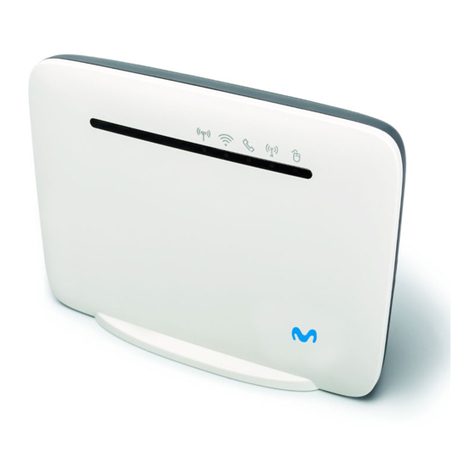
movistar
movistar WLD71-T3 User manual

movistar
movistar Home Station ADSL User manual

movistar
movistar Home Station VDSL2 User manual
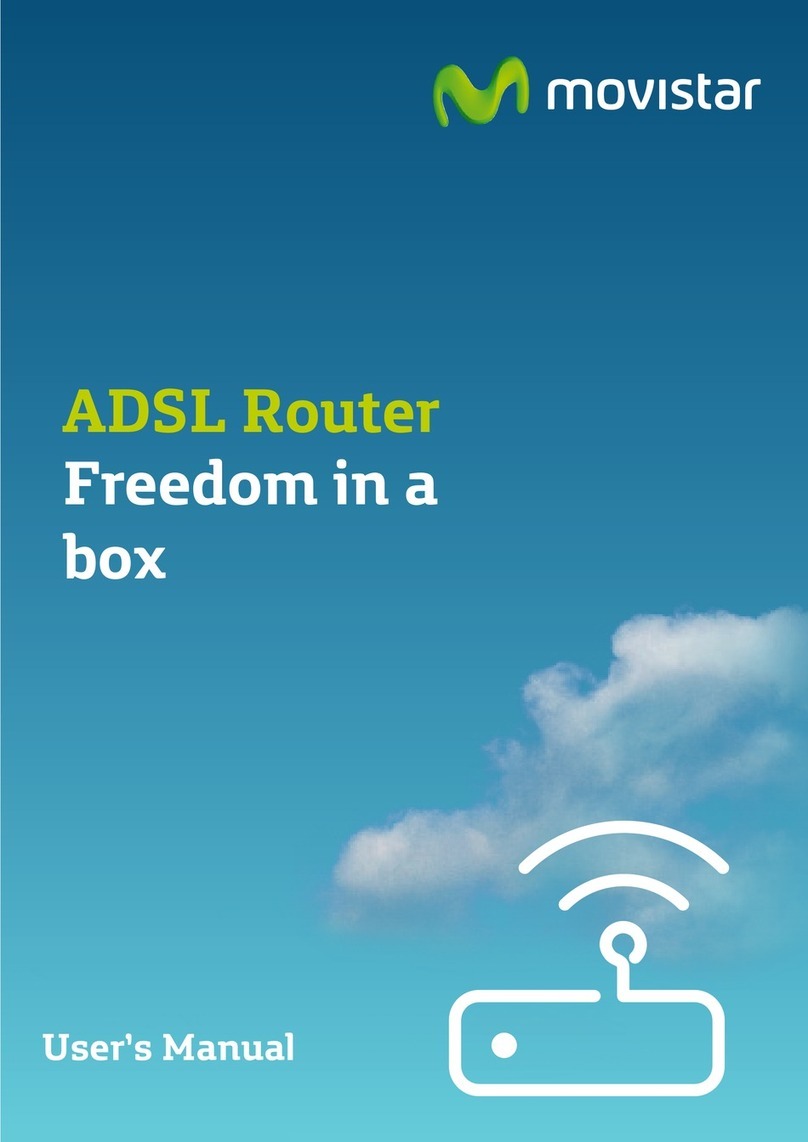
movistar
movistar Zoovel Z-201 User manual

movistar
movistar Home Station Fibra Optica User manual

movistar
movistar Home Station ADSL User manual
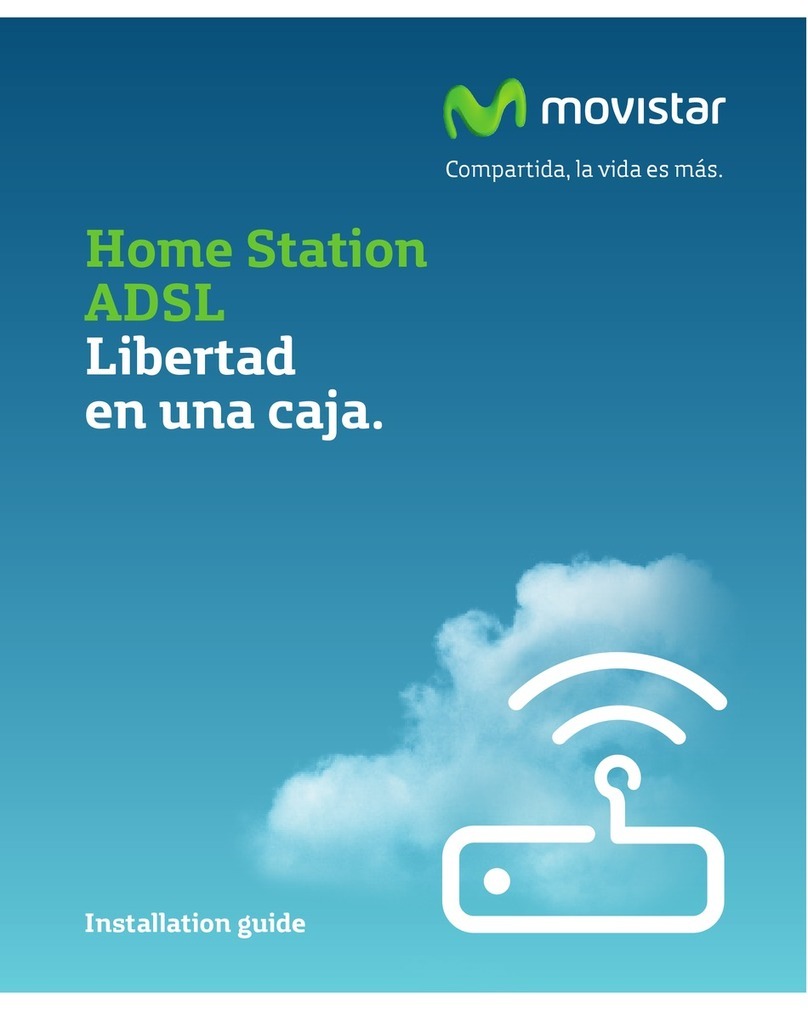
movistar
movistar P.DG A4001N User manual
Popular Network Router manuals by other brands
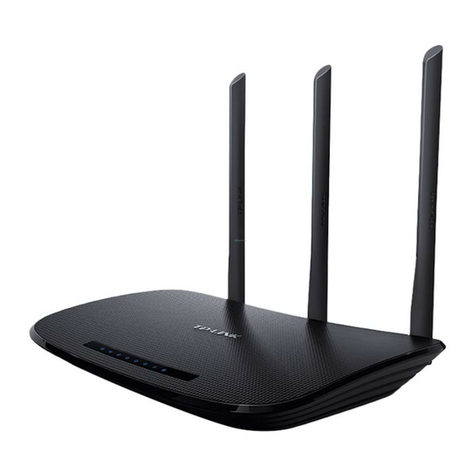
TP-Link
TP-Link TL-WR940N user guide
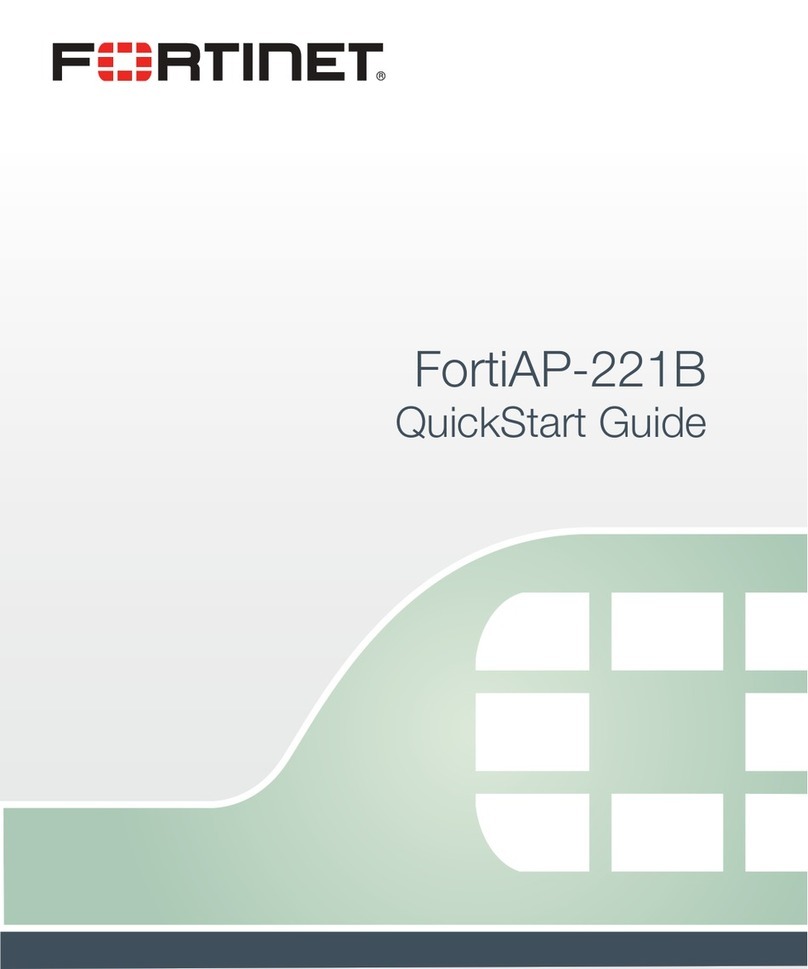
Fortinet
Fortinet FortiAP-221B quick start guide
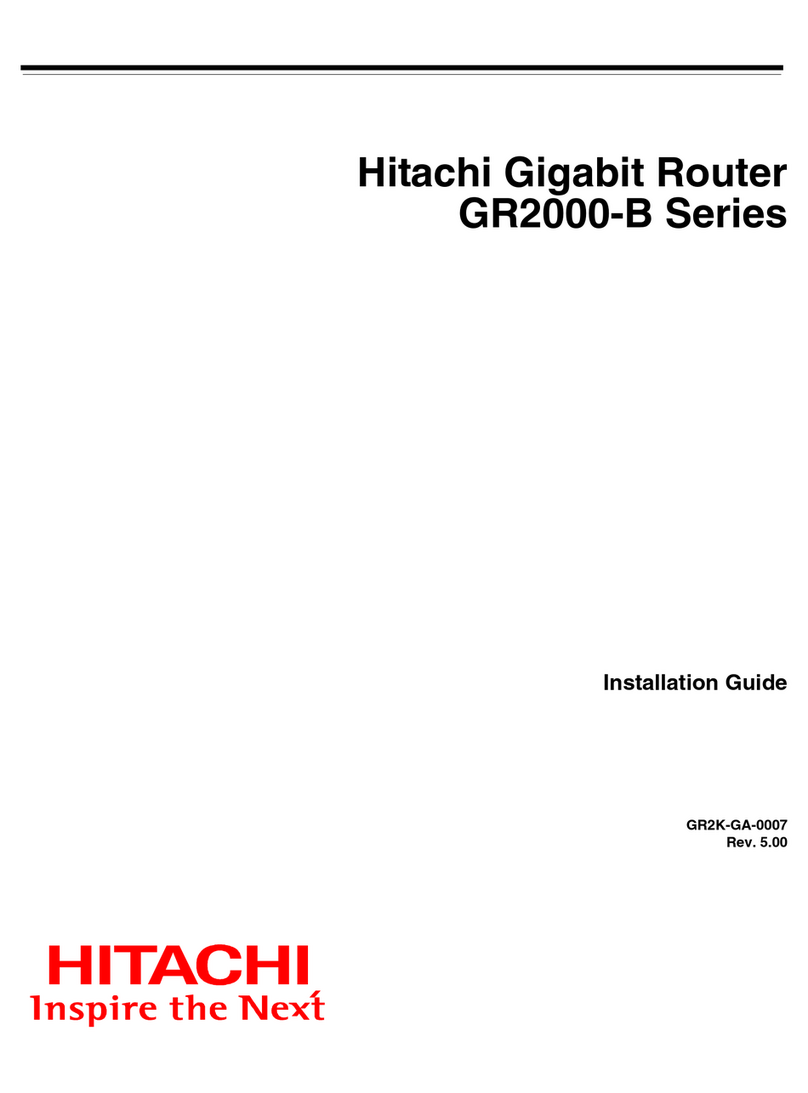
Hitachi
Hitachi GR2000-B Series installation guide
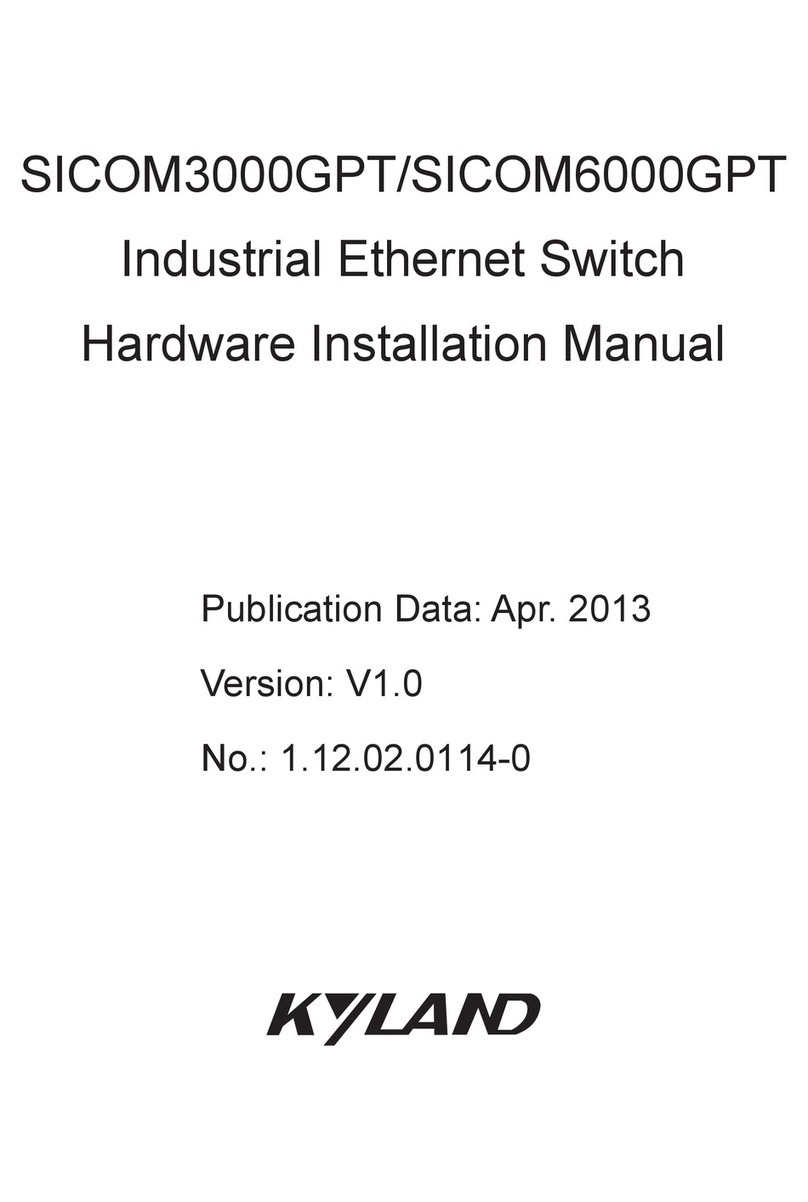
KYLAND Technology
KYLAND Technology SICOM3000GPT Hardware installation manual
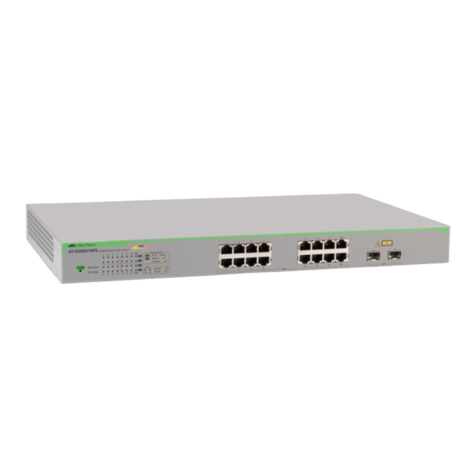
Allied Telesis
Allied Telesis AT-GS950/16 user guide
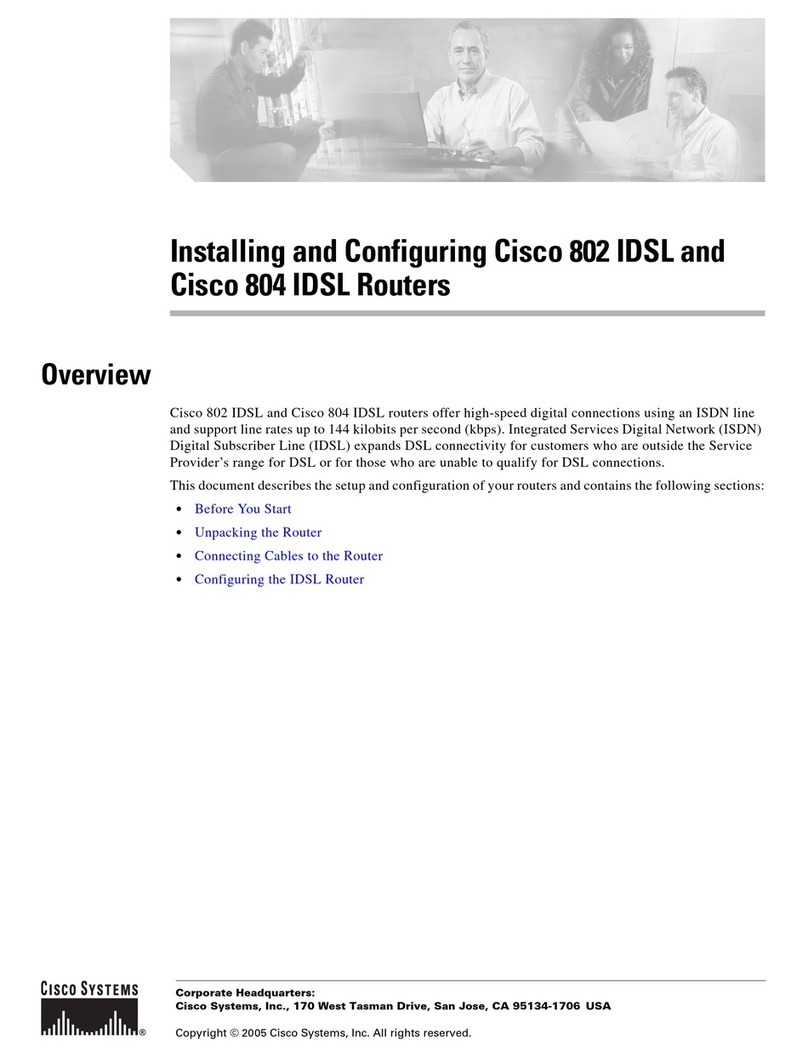
Cisco
Cisco 802 Installation and configuration guide
